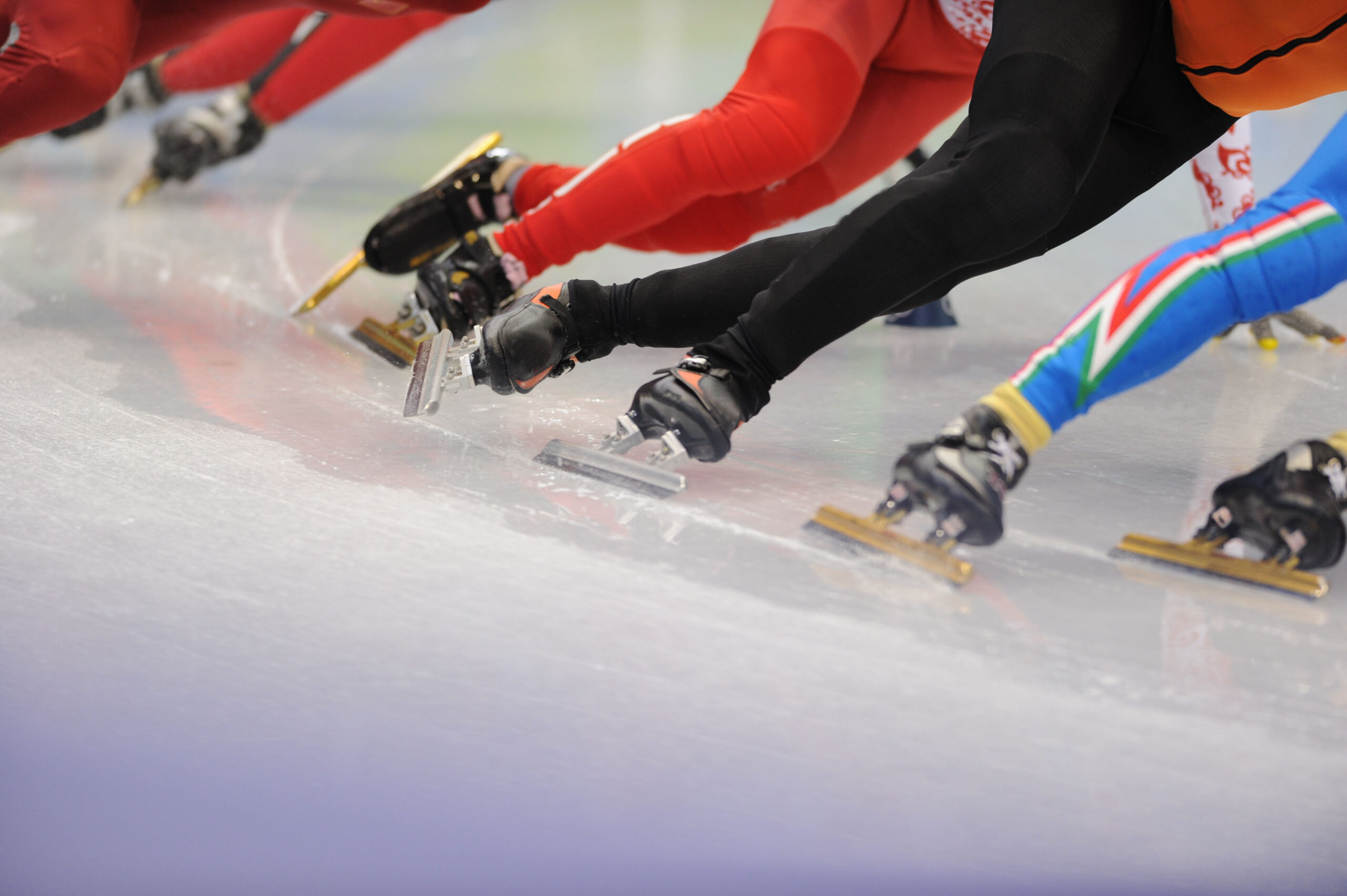Case Study of the Month: Speed Skating Mayhem
Welcome to the case study of the month, where we take a look at some of the toughest cases in Sports Medicine and Physical Therapy. We break them down into segments that are easy to understand in the hopes that you learn the value of an experienced Sports Medicine/Physical Therapy Provider.
 Short Track Speed Skating is by far the most stressful sport I’ve ever covered. Skaters are going around an ice track at high rates of speed; sometimes in excess of 35 miles per hour. In the meantime, they have to remain upright on what basically amounts to a pair of razor blades. These skates are SHARP. Walls are padded, but there isn’t much forgiveness when you’re flying into the hockey boards; even if they are lined with thick foam pads. Skaters often have to execute passes with such precision that they come within an inch (or less) of a collision. If you want a sample of the pandemonium, watch this video of a short track mixed team relay from the most recent Winter Olympics.
Short Track Speed Skating is by far the most stressful sport I’ve ever covered. Skaters are going around an ice track at high rates of speed; sometimes in excess of 35 miles per hour. In the meantime, they have to remain upright on what basically amounts to a pair of razor blades. These skates are SHARP. Walls are padded, but there isn’t much forgiveness when you’re flying into the hockey boards; even if they are lined with thick foam pads. Skaters often have to execute passes with such precision that they come within an inch (or less) of a collision. If you want a sample of the pandemonium, watch this video of a short track mixed team relay from the most recent Winter Olympics.
I was working at a high profile skating event several years ago. The arena was packed, excitement was high, and all eyes were on the ice. The race began in the typical fashion – quick and steady with ever-increasing speed. Somewhere toward the end of the race when the speed really begins to pick up, the skaters are traveling so fast around the bend that they have to transfer all of their body weight to a single skate blade in order to maintain their lean and balance. All of a sudden, one skater lost an edge, slipped, and sailed into the boards. Normally the walls are made of very thick cushions that are held together by very durable bungee cords. They’re designed to have a lot of “give” when a skater crashes. It was not the case at this particular event. Being a special event that was held at a hockey arena, the mats were thick. But, they were held together by the boards you would normally see at an ice arena. This created much higher forces on impact.
The skater landed fairly hard, but also in an awkward manner. His skate was positioned in such a way that upon impact, the blade actually penetrated his thigh. I watched him pull it out of his leg, and blood spilled out pretty quickly. There was a fairly large panic in the crowd, as this was in a small stadium where most people could see just about everything. This particular skater just happened to crash right in front of his cheering section of family members and friends, so you can imagine the scene was quite dramatic. The Sports Medicine Team was then called onto the ice.
Immediate Observation:
- Speed Skating athlete – conscious, distressed, clearly in pain, unable to get up.
- Bleeding is profuse, apparent, and obvious, appearing to originate from the thigh.
Subjective Report:
- Significant pain.
- Panic and fear setting in.
Objective Findings:
- Bleeding appears to be venous in nature.
- No spurting or large arcs.
Primary Clinical Impression:
- Significant Laceration to thigh caused by skate blade.
In-depth Breakdown:
I was tempted immediately to start running out onto the ice, but hesitated. A young man (non-medical professional) who was standing next to me threw caution to the wind and jumped the boards. He ripped his shirt off and applied pressure to the wound using his shirt as a bandage. In a panic, he was yelling “MEDIC! MEDIC!” We arrive on the scene after being called on by the officials, and the young man continues to shout orders in a panic. We convince him to let us take over, and we apply pressure to the wound as a team.
Well-aimed, direct pressure is the best way to control bleeding. We did this as a group, and ended up using Exxo-clear (think thick plastic wrap on a small roll) to add passive pressure while we transported him to the ambulance.
If that weren’t enough to deal with, we discovered that there were several people who had to be helped out of the arena because they couldn’t handle the sight of blood. After assisting the athlete on the ice, it seemed that we were actually spending more time helping people in the stands following the injury.
Outcome and Discussion:
It was a relatively quick incident when all was said and done. It’s my understanding that the athlete was taken pretty quickly to the hospital.
Here are a few things to reflect on that are important:
Some may wonder why I hesitated to head out onto the ice. Certainly the young man who bolted out there got there first, and caught the eye of the entire crowd (and the press). But as a medical professional, you can’t just start running out there. Rule number one when approaching an injury scene is always: Make sure the scene is SAFE. Remember – we have several other skaters traveling at high rates of speed who are unable to just stop on a dime. These skates don’t work the same way as hockey skates. So that would be a major safety issue if we just rushed the ice. I had made this mistake earlier in the week and almost caused quite an accident.
The other reason is that it’s ALWAYS better to be the calm one in an emergency situation. If the heart rate gets up too high, or you begin to go too fast, panic can set in and you can make mistakes. Any seasoned emergency care professional will tell you: when everyone else is in a panic, we have to be the calm among the storm. It’s the only way to keep a clear head and provide the best care. This also happened to be an especially high-pressure situation. The event was televised internationally. The athletes were of the highest caliber. The way the pads were set up increased the risk for injury. The competition was extra fierce because it was a qualifying event. When injuries happened that weekend (there were a lot), the pressure was on the medical staff to perform at the highest level.
The Exo-clear was an important detail. I’ll digress a little to tell this portion of the story. Every so often in my career path I’ve run into strange professionals. These people are usually independent, unlicensed practitioners who are in and around the sports medicine world. The “Trainer” who has really been the equipment manager for 30 years who everyone just kind of started going to for medical issues. The “Sports Therapist” who read some books and just loves to be around sports. They won’t really tell you what their credentials are, and aren’t really able to answer any questions about what they do. There was one such person at this event who was paid by one of the athletes to travel with them and provide care.
If I’m honest, this irritates me on the front end. I worked hard for my credentials, put my education to work, keep things legal, and continue to keep myself up to date to be the best practitioner I can be. As off-putting as these types of people can be, I do often find that these practitioners are actually very good at what they do. But I firmly believe that getting legally credentialed to practice in your field is an absolute must – regardless of the type of work.
Getting back to the Exo-clear. The reason I believe the Exo-clear was so memorable was because the uncredentialed sports therapist was the one who started to administer the treatment. I believe this technique really helped control the bleeding effectively because it provided a tight compression wrap (almost like a tourniquet) directly over the wound. I remember thinking to myself sheepishly: “That’s genius! Why didn’t I think of that?!” While a team of Doctors, Medics, and Athletic Trainers were holding manual pressure on the wound, she came in with the best solution possible. Certainly a humbling experience.
When everything was said and done, the athlete was taken safely for advanced care. Those in the crowd who needed care received it at the highest level. We worked together as a team and learned a lot. I took away a lot from this experience. I learned to be patient, more humble, think clearly, and be very aware of my surroundings. This was an experience I will never forget and am proud to say I was a part of. For more information on Athletic Trainers and the education and credentialing process, visit www.nata.org.
![]()
![]()

